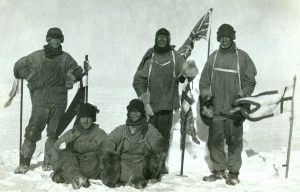One hundred year anniversary of Captain Robert Falcon Scott's heroic voyage
 One hundred years ago today, Captain Robert Falcon Scott arrived at the South Pole - 33 days after his rival Amundsen. The rest, as they say, is history as sadly they never made it home, but for WWT this day played a pivotal role in its own history.
One hundred years ago today, Captain Robert Falcon Scott arrived at the South Pole - 33 days after his rival Amundsen. The rest, as they say, is history as sadly they never made it home, but for WWT this day played a pivotal role in its own history.
Found beside the bodies was Scott’s famous last letter to his wife which included the immortal words about their two-year-old son Peter: “Make the boy interested in natural history if you can; it is better than games”.
That she certainly did, and 65 years ago in 1946, Captain Scott’s son, Peter, founded the Severn Wildfowl Trust, later to become the Wildfowl & Wetlands Trust, (WWT), with a national network of wetland centres across the UK.
Said to be the most influential conservationist of the 20th century, Sir Peter Scott was also the first to be knighted for his contributions to nature.
“Peter aroused the world in a way that was before his time,” Sir David Attenborough said. “He became a universal figure. He made everyone realise that the natural world is in danger from ourselves and we have a responsibility to do something about that.”
Peter’s father, Captain Scott was also admired by Attenborough, who spoke about his legacy to a captivated audience at WWT’s London Wetland Centre recently.
“Make no mistake, Captain Scott was a hero and his party were great human beings,”
He may have written in his diary "Great God! This is an awful place and terrible enough for us to have laboured to it without the reward of priority." But that hasn't stopped scores of people, particularly over the past few decades, wanting to repeat the famous journey.
Scott left a legacy of “courage, amazing superhuman courage,” Sir David added, recalling his own discomfort on stepping into the empty Antarctic hut from which Scott’s party launched their successful attempt on the South Pole.
“It was mostly a smell of tar, rope and antiquity. There was an anorak hanging on a hook and a bench with the test tubes and Bunsen burners with which Edward Wilson [the expedition’s scientist] did his experiments."
“Suddenly I felt I couldn’t stay any longer,” Sir David added. “I felt the personalities of these huge extraordinary characters who opened up the Antarctic. I had to get out of the hut. It was an experience I will never forget.”
Sir David’s recollection was among highlights he recounted to mark the publication of Edward Wilson’s Antarctic Notebooks, a collection of the naturalist’s sketches and paintings.
Dr Wilson was a member of both Scott’s expeditions and the book incorporates a selection of artwork from the two journeys. The scientist’s body and his drawings and watercolours were found alongside Scott’s corpse after the exhausted and demoralised party ran out of supplies on their return from the South Pole. They had been beaten to the frozen landmark just months earlier by Norwegian Roald Amundsen.
WWT Chief Executive Martin Spray stressed the inspiration Captain Scott drew from Dr Wilson and the legacy for WWT of Captain’s Scott’s words for his son. “That simple message, in my view, changed the world,” he said. “Peter Scott was a man of extraordinary achievements.”

